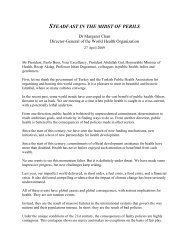The Evolution of HTA in Emerging Markets Health-Care ... - TREE
The Evolution of HTA in Emerging Markets Health-Care ... - TREE
The Evolution of HTA in Emerging Markets Health-Care ... - TREE
Create successful ePaper yourself
Turn your PDF publications into a flip-book with our unique Google optimized e-Paper software.
OHE Consult<strong>in</strong>g Report for PhRMA<br />
5 January 2011<br />
<strong>The</strong> current Brazilian public health care system dates from 1988, with the creation <strong>of</strong> the Unified<br />
<strong>Health</strong> System (SUS). With the new constitution, health was declared to be a citizen right and a duty<br />
<strong>of</strong> the State. SUS was created to provide universal, comprehensive, and equitable health care to the<br />
Brazilian population. To this day, the discussion about which right—universal coverage vs.<br />
comprehensive coverage—should prevail has not been answered, s<strong>in</strong>ce without enough fund<strong>in</strong>g,<br />
one or both <strong>of</strong> these will be affected.<br />
<strong>The</strong> Brazilian healthcare system has gone through a number <strong>of</strong> changes over the years. In 1923, the<br />
landmark Eloi Chaves Law was passed, which brought <strong>in</strong>to existence a form <strong>of</strong> ‘regulated citizenship’<br />
where social welfare benefits were restricted to private sector workers with regular wages. Social<br />
security and coverage <strong>of</strong> healthcare benefits (based on compulsory contributions from employers<br />
and employees and delivered ma<strong>in</strong>ly through the private health sector) were tied to the workplace:<br />
an outcome similar to the situation <strong>in</strong> the US. This left millions <strong>of</strong> agricultural and <strong>in</strong>formal sector<br />
workers un<strong>in</strong>sured. Elias and Cohn (2003) have argued that as long as the Eloi Chaves Law governed<br />
the structure <strong>of</strong> the Brazilian health system, implementation <strong>of</strong> the pr<strong>in</strong>ciples <strong>of</strong> universality and<br />
equality (<strong>in</strong> healthcare access and provision) was impeded.<br />
However, the new constitution that came <strong>in</strong>to effect <strong>in</strong> 1988 changed the exist<strong>in</strong>g two-‐tier<br />
healthcare system that operated. <strong>The</strong> new constitution paved the way for SUS, based on a<br />
regionalized and decentralized framework—under which the private sector’s <strong>in</strong>volvement <strong>in</strong><br />
medic<strong>in</strong>e was relegated to a ‘complementary function’ with priority given to philanthropic and not-for-‐pr<strong>of</strong>it<br />
organizations. However, the SUS is not a s<strong>in</strong>gle payer healthcare system cover<strong>in</strong>g the<br />
whole population. People may buy private <strong>in</strong>surance but cannot opt out <strong>of</strong> the public system, and<br />
they must cont<strong>in</strong>ue to pay taxes devoted to health care. In effect, the reform moved from one two-tier<br />
system to another two-‐tier system (SUS plus the Supplementary <strong>Health</strong> <strong>Care</strong> System), but with<br />
obviously a different mode <strong>of</strong> operation. This ‘new’ form <strong>of</strong> segmentation created opportunities for<br />
adverse risk selection <strong>in</strong>to the publicly-‐funded SUS (Elias and Cohn, 2003).<br />
<strong>The</strong> provision <strong>of</strong> health services was decentralized with a hierarchy among the federal level, state<br />
level, and municipal level. <strong>The</strong> rules <strong>of</strong> provision are: 1) <strong>in</strong>tegral care, with priority to prevention<br />
activities without damage to assistance activities; 2) decentralization with unique direction <strong>in</strong> each<br />
level <strong>of</strong> government; and 3) participation <strong>of</strong> the community. <strong>The</strong> SUS was def<strong>in</strong>ed as composed by<br />
the actions and health services provided by public bodies and <strong>in</strong>stitutions at the federal, state, and<br />
municipal levels. Private <strong>in</strong>stitutions may participate <strong>in</strong> SUS as a complement, but philanthropic and<br />
not-‐for-‐pr<strong>of</strong>it organizations are given preference.<br />
Population and Coverage<br />
Population: 193 million people (IBGE, 2010)<br />
<br />
<br />
Total health care expenditure per capita <strong>in</strong> 2007 (WHO, 2010): US$ 606 (average exchange<br />
rate) or $ 837 (PPP <strong>in</strong>t $)<br />
Total health care expenditure (WHO, 2010) = 8.4% <strong>of</strong> Gross Domestic Product<br />
o Private expenditure on health as percentage <strong>of</strong> total expenditure on health: 58.4%<br />
o Private prepaid plans as percentage <strong>of</strong> private expenditure on health: 39.4%<br />
70








